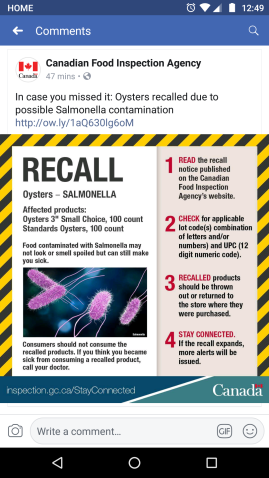So this popped up in my alerts today…
A question I was asked quite recently, why has there been so many Salmonella outbreaks? Traditionally, Salmonella has been associated with chicken and eggs. However, recently there has been outbreaks in sprouting mixes (2), cheese flavoured crackers (3, 4), and frozen berries (5). The differences between these outbreaks and the ones involving frozen breaded chicken products is that we expect Salmonella in chicken. One of the reason why there has been an increase in warnings regarding frozen breaded chicken products is because people don’t read instructions. While the majority of people cook their chicken in the oven for the required amount of time, there is a group of people who do not. Generally speaking, frozen breaded chicken is not fully cooked before being frozen. They are par-fried (partially fried) and then quick frozen for quality. So if you don’t cook it via the instructions, you’re eating raw chicken and increasing your chances of getting Salmonella. The microwave doesn’t cut it, there are hot and warm spots!
Now why are we seeing more Salmonella in foods not traditionally associated with this bacteria? The short answer is we don’t know, yet. There is speculation that it is because Salmonella is ubiquitous, meaning that that these organisms are found EVERYWHERE. However, if the food plants don’t do their due diligence when it comes to plant maintenance and cleaning, that could be another source of bacteria. One of the most famous cases of Salmonella that got food scientist scratching their heads is the outbreak involving peanut butter in 2009 (6). In that case, it was revealed the plant had roaches, rats, mold, dirt, accumulated grease AND a leaky roof (7). Now most plants are generally not in such a state of disrepair, at least I hope not.
One positive thing to take from all these outbreaks is that there are investigations being done. There are hard working food safety specialist, scientist, epidemiologist figuring out where the source of contamination, containing it by sending out alerts, and researching way to prevent these occurrences.
